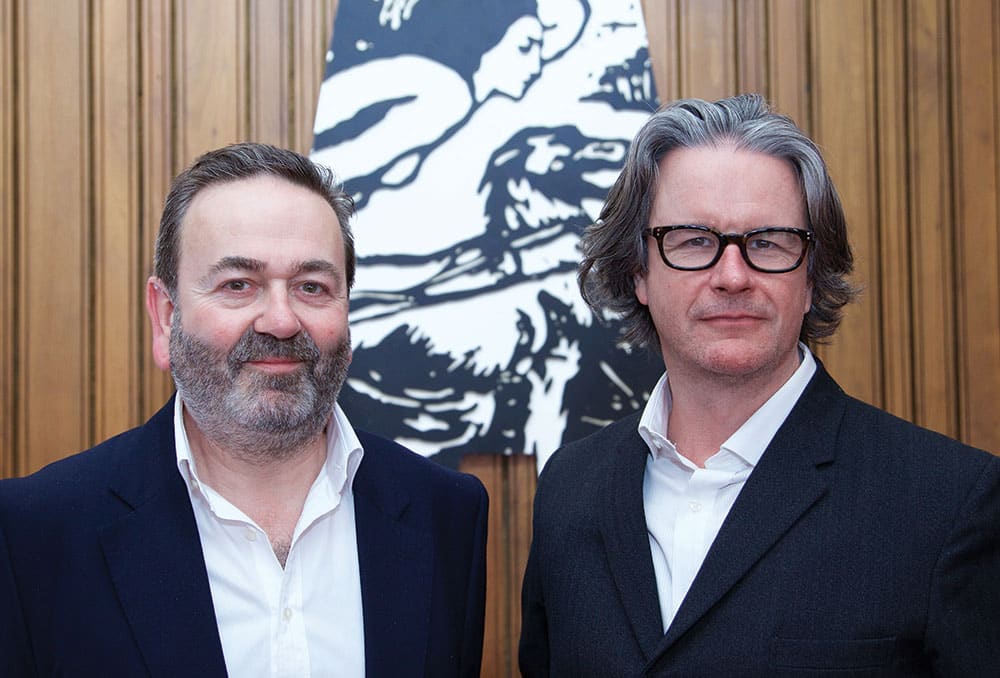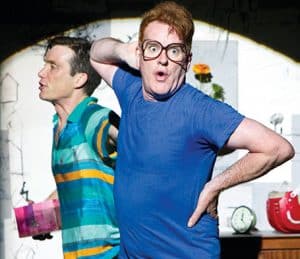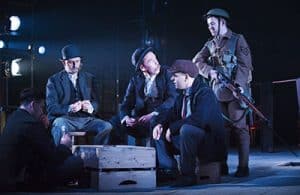I enter the sempiternally dingy Abbey by the stage entrance and advance up the mid-century staircase to a poky room alive with two middle-aged but effervescent non-Irish Celts. The guy at the desk has said he sees a lot of them and they seem effortlessly in control. They’re informal, blithe, cheerful and open throughout our whistlestop chat, bantering with each other supportively, and joshing.
Can you just please describe your backgrounds and records in the arts?
Murray: “I’m from South Wales (McLaren thinks this is shaping up to be like a dating pitch). I‘ve worked as usher, stage technician and eventually front-of-house manager, in the Citizens Theatre in Glasgow. Stayed at the bottom for quite some time. Worked for 7:84 Company in Glasgow – a political touring company particularly touring rural Scotland. Ran a building, a beautiful converted church, the Tron Theatre in Glasgow as creative producer. I was the inaugural executive producer of the new National Theatre of Scotland based on a model of a theatre without a building, without walls, for eleven years”.
As to what he brings that is special he says “I hope I’m an imaginative producer I have an eye to initiate and exploit and get the most out of them and I have a good all-round knowledge, love, passion for the theatre”.
McLaren stops us to note that “John Tiffany, maybe the most significant theatre director of his generation (much as it pains me to say it) characterises Neil Murray as ‘the best theatre director on the planet’”. Murray intervenes to say drink had been taken.
McLaren: “Neil and I have been associates for 20 years. When Murray ran the Tron theatre, I ran a touring company called Theatre Babel and we toured across the planet. Like Irish theatre, Scottish theatre is very small. He ran a venue and I ran a touring company. We kinda needed each other. When I joined National Theatre of Scotland we worked together again. In the last five years we worked together on a number of significant projects especially around the social and political changes in Edinburgh. I’m not sure what I bring to the table”.
Murray intervenes to explain that he’s “primarily a very fine director of plays” and McLaren agrees “I direct and design plays”. “Coming to Dublin, we didn’t see it as an opportunity to replace what had been before but to envisage a new working model”.

The Abbey describes its mission as “to create world-class theatre that actively engages with and reflects Irish society”. So what’s the vision for the Abbey, and has it changed?
McLaren: “There’s nothing we could argue with. That mission statement is always going to be the case. The problem when you give a phrase like that is that it sounds like a set thing. It’s responsive to the ever-changing Irish and global society socially and economically that we find ourselves in. Murray intervenes “It doesn’t really dig into how we think the Abbey will be working and how it fits in Irish theatre and society”.
McLaren resumes: “it’s a great privilege to inherit an organisation with such a remarkable past but we have to be cognisant of the fact that its best years are ahead of it. As an organisation it’s been a long time since it’s behaved and thought of itself as if it’s best years are ahead. It’s way too quick to rely on its past brilliance to justify its existence rather than what we will do next year or the year after”.
But the protagonists have always said this, I note.
According to McLaren they already have. Murray says, “I think the way the building’s work in terms work we’re producing ourselves and presenting with others’ work It’s a different model already. We’re saying, ‘The national theatre stage belongs to other people as well, not just the Abbey’. That is something that’s been ignored. So for example tonight, Druid: Waiting for Godot. Druid haven’t been here for over a decade. It’s a brilliant production that should be seen at the national theatre. Our programme for the year reflects that more open approach”.
So will there be more co-productions?
“More presentations, co-productions. A mixed economy. The days of being able to produce huge shows eight times a year: it’s not what the theatre public want – they want a faster turnaround of activity. Economically it doesn’t make sense to do that it makes sense to be lighter on your feet ,working with wider range of people and artists from Ireland and perhaps further afield. In the end the audience define what the Abbey is. Going back to values, we have to believe anything we put on the Abbey stage is hopefully world-class and reflects modern Ireland.
McLaren says “We said we’d investigate the three words around national Theatre of Ireland. What does it mean to be National? For the first time ever we’re about to go to Leitrim simply because it’s about Leitrim, no other reason: because it’s there.
Hitherto the company’s attitude would have been we’ll put on some matinées and ensure the good people of Leitrim will be able to see it on a Saturday afternoon or we’ll do a special gala performance. No we’re going to go and make it there and use locals to build the show. That’s the first time in the company’s history that it’s explored what it means to be truly geographically National and Irish, and the different kinds of Irishness from the diaspora through to the new Irish who don’t even speak even English: they also have a national theatre – we’re it and we have a building on Abbey St. But we’re not confined to that”.
Are there dangers to co-producers of subsuming to the Abbey and losing independence?
McLaren notes: “We’re there to collaborate”.
Murray says it’s “The opposite. ‘Dublin by Lamplight’ by Corn Exchange, ‘The Train’ by Rough Magic and many other shows would not have happened if we had not said we’ll take the risk away from you – we’ll effectively help you get that show on its feet. And then you have something that can then go further.
You’d have to ask them, but I don’t think they feel they’ve been subsumed. Firstly, people are excited by the possibility of performing on the Abbey stage – a beautiful theatre with that sense of, for Irish artists, ‘it’s my national theatre, I belong there’. And secondly it gives them the chance for that show to have a further life. The Abbey’s always going to be the focus of attention because it gets 50% of the theatre budget for Ireland. Our view is instead of saying we’ve 50% and everyone else has 50% say we’ve all got 100%, let’s work out the best way to use it”.
Will there be more emphasis on iconoclasm? Fintan O’Toole recommended a return to “Yeatsian arrogance”.
“I don’t think of it in those terms though it’s great that Fintan does”, says McLaren.
“I’d like to hear what Fintan means and how it would manifest itself. Maybe we have more of that Yeatsian arrogance. Who knows? We have a drive and we’re not from the parish so we don’t have the nuanced understanding of what that Yeatsian arrogance is. But in a way that’s quite liberating”.
Would they like to see the theatre making more impact?

[Brief silence]
“Of course we’d like it to have more impact. No-one’s ever going to say we’d like to make less impact. Some of things we’re doing include free previews, and very cheap tickets.
A guy doing the drains in my house said ‘I’d love to go to the Abbey but I couldn’t afford it’. I said you know you can get in for free. For every Abbey production we do ourselves, the first preview will be free, starting with ‘Room’. You come on the night, form a line around the building, get in, if you don’t like it leave. If you book in advance you’ll get an early-bird ticket for €10, though of course you can pay up to €40. The average yield for a ticket for the Abbey main stage is €23. Compared to average prices in the UK that’s very low. Regardless of your gender, your sexual preferences, your geographical background, you still have a National Theatre, however much you have in your pocket. The way we address the need for social sensitivity is we make it cheap or free”.
How political do you think the Abbey should be?
McLaren states: As political as it needs to be in the moment.
Are you taking ideas from the Scottish National Theatre?
Murray says: “Some of the ideas about touring, site-specific and Community-specific work, embedding working communities. Thinking of some of the artists we worked with there, seeing a crossover between Scottish and Irish artists”.
Do they have favourite authors?
“No”, laughs McLaren. “The next one. Very wide. The one we’re working on”.
What are you doing with the Peacock?
“Opening it. It’s constantly open from the end of March until the end of the year. Again that programme’s going to be a mixture but we’re going to produce work ourselves, invite others to present, we’ll invite companies in to do work, we’ll do workshops financially supported by the Abbey. We’re about to do a series of three very quick-response pieces to current political scenarios. ‘A Whisper Anywhere Else’ by Jimmy Murphy which robustly examines the treatment of Garda whistleblowers is currently getting enthusiastic reviews. Each performance is followed by a discussion. We’ll really have the whole place turning work over quickly”.
What specific playwrights will we see more of?
“More of them all”, says McLaren. “That’s way too specific. That’s like saying what lyrics are going to be in the next song you write. It’s much more collaborative than that”.

“Probably not on the stage of the Abbey, for a while. A small moratorium. No new productions planned”.
How do the two of you work together? Does it make sense for you both to have the same title, Director?
“Fractiously”, jokes Murray. “There’s a temptation to say he’s the arty one; he’s the business one, but actually he’s as adept at a budget as I am at coming up with an idea for a show. I think the skill set does work well. If Graham’s going to be in the rehearsal room for 15 weeks it makes sense that I’m still here and the ideas still come through. It works pretty well”. [Graham says “he’s lying, get me out of here”].
Have there been any surprises?
“Coming into a building you’ve never worked in is always surprising”.
McLaren says: “I tell you what’s great is the care that’s taken of artists here – it is rare”. They’re both enthusiastic.
“We arrived the day after the death of the great Brian Friel. I bought the Irish Times at the airport and there’s an eight-page obituary pullout edited by Fintan O’Toole. I can’t think of a country in the world that would do that for a playwright. Maybe in the old Eastern block. In Scotland it would be underneath the Celtic- Rangers results”.
Murray says: “The theatre tradition has been a very literary theatre tradition. There’s a generation of new artists coming through who don’t necessarily see that. We have to find a place for them at the Abbey. It’s not just about honouring the literary tradition but looking at a modern theatrical landscape”.
I ask about funding.
Murray notes: “The Arts Council has funded us up to around €6m for the last few years. It went down significantly after the crash. There’s no deficit at the moment – there may have been a small operating deficit last year but the Abbey ‘s not ‘in deficit’ and they’re not expecting one this year. We’ve sold 27,000 tickets, 45% of which are new people to the Abbey and 35% of that 45% is under the age of 35. Clearly there’s a new audience out there, young and keen to see this material. We’ve also published a programme for a year in advance and that has attracted early interest.
The kind of work we’re doing helps: it helps opening with two pieces by Enda Walsh. Though he’s a wonderful writer he’s not entirely focused on the literary aspect.
If we spend it right and collaboratively also at the moment supporting a range”.
McLaren again says you can’t think of it in a binary way.
Ask Druid, Ask Corn Exchange, ask Moonfish who’re in the Peacock now. If we extend the national theatre as a resource for the whole nation’s theatre then of course it’s money well spent”.
“The period of staff cuts is over. We’re trying to make the most of our money, the most of our brilliant staff”, says Murray.
Are they prioritising the rebuild of the Abbey? [Fiach MacConghail bought adjoining buildings at keen prices in recent years]
“It’s been a priority for most people. The trouble with this building is it isn’t fit for purpose, it never has been, we don’t have a dedicated rehearsal space.
We have Portakabins on the roof of the National Theatre, that tells you how dysfunctional, the theatre, the nation, the city all deserve it. It needs to be redesigned. We’re taking it very seriously”.
What is the timescale? Do they think it will happen during their time?
“Tomorrow. We’ll announce it tomorrow”, says McLaren. Murray says: “No it’s very much in our view and we’re working on it”. They don’t know. Indeed they don’t know how long they’ll be in the Abbey. “It’s a five-year contract. We’ll be dead”. [MacConghaile did 12 years].
They’d like to incorporate the old stones that are being used for an open-air theatre in Docklands in the new Abbey.
Should all processes in the Abbey be discrimination-proofed? [They have committed that “There will be ongoing flexibility within programming for a given year but over the course of each five year period the artistic programme will achieve gender balance”]
“The 1916 programme had an imbalance but I think the Abbey has worked harder than any organisation. There will be ongoing flexibility within programming for a given year but over the course of each five year period the artistic programme will achieve gender balance”. They deny this is ambitious. “It’s not”.
Does “balance” mean equality?
McLaren asks queriously “we’re talking about equality of opportunity?”. Murray emphasises that it’s over five years. It’s not about equal numbers of playwrights but about, they chime, “equal numbers of artists”. To say we’d have 35 male designers and 35 female designers, for example: that’s wrongheaded, says McLaren. “The binary thought that it’s only about writers is wrong. We’re talking about how theatre is made, who are the lead artists? What if the lead artist is a female choreographer who wants to work with a male writer? Unfortunately it’s not as quantifiable in that binary way as anyone would like. The important thing is about discrimination. I don’t think there’s ever been a sense of discrimination. There is now a proactive approach not just to equality, gender but also to geography, social, ecomony and sexuality because we get public money – your granny’s taxes pay for what goes on here. But it’s never been discriminatory. That’s a key point”.
I note that in effect the commitment is for “positive discrimination”, not about just representing the politics or makeup of the country. Murray doesn’t see it as positive discrimination: “There are more female directors on-stage in our first season than in its history”.
Is there a danger that the new policy will be to the detriment of quality?
McLaren bridles a little and agrees it’s a challenge. “Of course it’s a challenge. The two things are not mutually exclusive. It’s very important that you understand that. The inference is that if it’s women it’ll not be good enough. That’s at the heart of your question. The two things are not mutually exclusive. Never have been. It’s wrongheaded to say that”.
As I exit onto dreary Abbey St I regret I haven’t pinned them on the issue of what they’re going to do to ensure quality but they were extraordinarily adroit in steering me away from it. The artistic and political processes are unassailable.
I decide that to be fair I’ll ask them explicitly for their view on quality. I ask the helpful Press Manager “to kindly ask either Neil or Graham for comments on how they’re going to achieve “world-class” standards and in particular address the criticism of the (independent Abbey/Arts Council) 2014 report that the Abbey wasn’t then reaching “an acceptable standard for professional theatre presentation”. There’s a bit of a kerfuffle over whether the quote (from the Irish Times) is accurate and eventually the reply comes through:
“This is not something Neil and Graham are going to comment on because it was before their time at the Abbey”.
For the Abbey in 2017 clearly the attention to the artistic and political processes is scrupulous. Whether the elusive world-class production quality can also now be assured seems to require our trust.
Interview by Michael Smith
